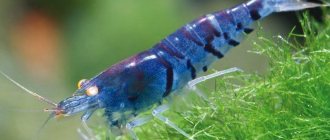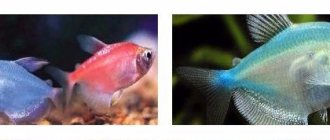Shrimp are extremely interesting and useful inhabitants of any aquarium. Their unpretentiousness to water quality and living conditions makes these freshwater creatures a good choice for a novice aquarist, while a professional will be interested in them due to their variety of forms and the possibility of flexible selection. Shrimp in a fish aquarium form a diverse and functional ecosystem, however, for its stability and prosperity, it will be necessary to carefully monitor the compatibility of all members of such an aquatic community.
Shrimp, who are they?
The most unpretentious species are cherry and tiger. They can be kept in the same container, but they do not interbreed. Amano, yellow canary, and blue dream are also quite popular, but certain conditions must be provided for them.
Externally, the shrimp is very similar to crayfish, but there is a significant difference in their structure.
The lifespan of one individual is no more than two years.
Shrimp can be kept in small or large tanks. Only the number and size of individuals depends on the volume of the aquarium. The advantage of crustaceans is that they like to scurry around at the bottom and pick up small pieces of food. The water will not become cloudy from leftovers and other waste.
Shrimp fry are so small that even the owner may not be aware of their appearance in the aquarium.
Under favorable conditions, crustaceans increase their population very quickly. To control numbers, individuals with light colors are selected, caught and relocated or sold to a store. Only the most beautiful shrimp with bright colors are left for posterity.
A large number of species of ornamental fish are omnivores. The small size of crustaceans allows them to be considered an addition to the diet. If the fish's mouth is larger than the crustacean's, then the shrimp will sooner or later become food. Once the fish understand that shrimp are food, they will start hunting and will hunt down all the small inhabitants until they eat them.
Description
Girinocheilus belongs to the carp family. Comes from rivers and ponds of Southeast Asia and China. Loves bodies of water with strong currents and a lot of algae and driftwood. In the east it is a commercial fish, which is why in some countries the natural habitats are on the verge of depletion.
Appearance
Golden Gyrinoheylus in nature grows up to 30 cm, and in an aquarium up to 12–15 cm. The body is oblong, slightly arched and flattened on the sides. The gill openings are designed in such a way that they allow the animal not to use its mouth when breathing. The eyes are large, yellow with a black pupil. The mouth is formed by a sucker and a scraper, thanks to which Gyrinocheilus tightly attaches to surfaces and gnaws algae. There are small outgrowths on the muzzle. The algae eater comes in gold, yellow and orange colors. The color can be spotted or plain. The fins are translucent yellow, orange or gray. The tail is forked. The dorsal fin is high and occupies a third of the fish’s body in width.
Behavior
The golden algae eater actively scrapes fouling from stones and glass. As a teenager, Gyrinocheilus is peaceful, but as it matures it becomes territorial and aggressive, especially towards competitors for food. It lives in all layers of water and is diurnal.
Lifespan
With good care, the pet lives for more than 10 years.
Neighborhood of shrimp and fish
Under natural conditions, krill is food for most fish species. But in the wild, small crustaceans have the ability to use protective camouflage. In aquarium conditions, it is very difficult for a small shrimp to hide or avoid an attack.
Arranging conditions for living together
- In their natural habitat, small shrimp use all possibilities to hide - bottom topography, soil, various objects, plants. If the necessary conditions are not provided, the bright and colorful crustaceans in the aquarium will lose protection and will be constantly in danger.
- When there are fish in the aquarium that are much larger than crustaceans, the shrimp will hide, even if there were no manifestations of aggression towards them.
- Crustaceans get along very well with these types of fish, which in no way encroach on their lives. These may be Boraras brigittae rasboras. These miniature fish are so small that they cannot encroach on the lives of even young individuals. The presence of such inhabitants will greatly revitalize the aquarium.
Rasbora Brigitte is so small that it fits perfectly into nano aquariums and shrimp tanks.
- If there are fish and young krill in the same tank, then moss and other small-leaved plants should be added to the aquarium. It will serve as a refuge for young individuals until they reach a safe size.
- In order to grow shrimp from fry, it is worth keeping a separate aquarium in which there will be no shellfish, fish or adult crustaceans, since the size of shrimp can range from 1 to 3 mm . This is especially true for dwarf species.
If shrimp feel constantly threatened, they begin to lead an active lifestyle at night. As a result, the color begins to lose its brightness.
Features of predatory shrimp
It should also be taken into account that when keeping fish, krill and crayfish together, you should choose the fish first, and only then the shrimp. The filter feeder shrimp is indifferent to other inhabitants of the aquarium, and simply takes a threatening pose if a potential enemy approaches it. But the crustacean species Macrobracium rosenberghi can not only attack fish, but also eat it. Such shrimps are very aggressive and often do dirty tricks. They can easily pluck the tail or fin of a fish during sleep at night. For this reason, it is not advisable to keep such crustaceans and fish with veil-shaped fins.
06:26
MACROBRACHIUM SHRIMP FIGHTS AWAY FROM BARBS
Shrimp species Macrobracium (ehelmals, mirabile, kulsiense), Palemonetes, Amano are kept with all aquarium fish if their size does not exceed six centimeters. Crustaceans Palaemon in a hungry state are quite capable of attacking small fish. For such inhabitants of the aquarium, neighbors with sizes from 5 to 10 centimeters are selected.
Good neighbors
First of all, it is worth saying that it is impossible to give a definite answer to the question of what fish shrimp get along with. There is no universal compatibility table for shrimp, since this parameter depends on many factors: first of all, the size of the aquarium, its level of population, including plants, landscape, temperature conditions, abundance of feeding and even the individual characteristics of each individual aquatic inhabitant. Therefore, in this matter you can only rely on personal subjective experience and the experience of other aquarists .
If we talk about specific species, then it is best for shrimp in an aquarium with fish to find a common language with the various “orderlies” of the aquatic environment. For example, Siamese algae eaters can live with rili shrimp. And not only the Siamese algae eater and shrimp are compatible in the same environment; all representatives of the genus crossocheilus (relatives of the above-mentioned algae eaters) get along well with unpretentious arthropods. Shrimp and ampullaria coexist well; they simply live in different worlds and have no idea about each other’s existence. Also, do not forget about a variety of catfish: the compatibility of catfish and shrimp is well known to aquarists, because these bottom-dwelling fish have a very peaceful character.
Under favorable conditions, ampullaria are very prolific, which can lead an aquarium to a real disaster. But if a small population of shrimp is kept with the snails, then the arthropods will destroy almost all the small ampullaria, maintaining the natural balance of the ecosystem.
Another large category of fish with which shrimp get along in the aquarium includes a variety of small, non-aggressive species. The compatibility of neons and shrimp can be estimated at almost 100%. The group of ideal fish for shrimpers also includes dwarf guppies, zebrafish, microrasboras, microplates, neon irises and parotocinclus.
Choosing neighbors for cherry shrimp
Cherry is the most popular representative of aquarium crustaceans. They get along well with fish that do not show aggression. But before placing shrimp and fish in the same tank, it is worth observing the behavior of the latter.
Cherry shrimp can get along with a betta if there is enough hiding place in the aquarium.
You can introduce zebrafish, microrasbora, and zebrafish without much fear. But in such aquariums, food for shrimp is placed in the midst of plants, where fish have no access.
Even if the fish do not attack the shrimp, the crustaceans will not reproduce. Despite the lack of a direct threat, cherries consider other fish as enemies.
Cherries get along well with other types of shrimp, but in such cases it is possible to cross several species with each other. All individuals living in the same tank must be the same size, otherwise the larger ones may take food from the smaller ones.
Shrimp with such a bright appearance are doomed to attract increased attention! For such an aquarium, fish are not required.
Riley shrimp are a mutation of the cherry. Their content and compatibility are no different from ordinary cherry tomatoes.
Compatibility of different types of shrimp with other inhabitants of the aquarium
There is no universal rule for the compatibility of shrimp and fish in the same aquarium. Most often you need to rely on the experience of other aquarists, or take risks.
Siamese algae eaters and catfish get along quite well with shrimp. Gouramis, guppies and swordtails can also live in the shrimp tank. But it is important to deliver food for krill into the moss or thickets. Thus. so that the fish cannot take away the food.
Neons will offend small crustaceans. To solve the problem, it is best to organize thickets and various shelters, or keep both species separately.
Neons can eat small shrimp, but they get along with Amano with a bang!
The cockerel is a predator that happily eats small crustaceans. Since this type of fish has luxurious fins, keeping it with predatory shrimp is also inadvisable (if they don’t eat it, they’ll bite it). In this situation, you have to choose: either cockerel or crustaceans. If you manage to select large-sized crustaceans that can fend for themselves, then the betta can harm the shrimp after the molting process, at a time when the shell has not yet hardened enough.
If there are ampullaria in the aquarium, then shrimp can cause great harm to them. Small individuals are often simply eaten, while larger ones have their antennae gnawed off. These snails are scavengers and cannot catch fast and healthy prey, so they do not pose a danger to other inhabitants.
With whom is shared housing contraindicated?
Many species of fish are neutral towards shrimp and simply do not notice them, provided there is enough food. However, there are others who are ready to attack when the environment changes from hunger or just like that, playfully. It is important to ensure that the water temperature in the aquarium does not rise. During the breeding season, it is recommended to move the inhabitants into different vessels.
It is quite dangerous to house crustaceans with swordtails and other viviparous species. Such neighbors can treat children neutrally today, and tomorrow begin cruel and targeted extermination. Large fish like platies, rhodostomus, and brochis can treat their neighbors as potential food. It is dangerous to combine shrimp with barbs, girinocheilus and cardinals in the same aquarium.
There are examples when arthropods and cockerels coexisted in the same territory. However, experts do not approve of such a neighborhood; it can literally end in a day with the complete destruction of the babies. Aggressive predators simply cannot live peacefully with shrimp. In this case, the fish perceive their neighbors solely as victims.
The death of the crustaceans in the first hours ends the settlement in the same territory with gouramis, goldfish, Ramiresi's apistogramma, pelvicachromis. Sometimes it happens that predatory fish do not attack schools of shrimp, but catch them one by one. Some species of large arthropods may attempt to defend themselves. However, in most cases, peaceful living in such a mixed aquarium cannot be achieved.
Macropod and shrimp cannot live together. Filter feeders will suffer from fish attacks. Things are especially dangerous when the shell is being shed. During molting, crustaceans are too vulnerable and become easy prey. If you choose larger crustaceans, then the fish are in danger; their small sizes make them potential victims.
To see what fish shrimp get along with, watch the video below.
Shrimp are extremely interesting and useful inhabitants of any aquarium. Their unpretentiousness to water quality and living conditions makes these freshwater creatures a good choice for a novice aquarist, while a professional will be interested in them due to their variety of forms and the possibility of flexible selection. Shrimp in a fish aquarium form a diverse and functional ecosystem, however, for its stability and prosperity, it will be necessary to carefully monitor the compatibility of all members of such an aquatic community.
How to create a favorable environment
If crustaceans are kept separately, an aquarium with a volume of 40 liters will be sufficient. Take up to two liters of water for one shrimp.
If krill will be kept with fish, then the volume of the tank must be increased to 100 or 150 liters. The community aquarium also provides plenty of hiding places and plants so that small crustaceans can find shelter. Large pebbles and hornwort, Java moss and cladophora are suitable for these purposes. You should not put too many plants in a container, as they take various minerals from the water that are necessary for crustaceans.
Crustaceans respond very well to water changes, so up to half the volume should be changed weekly. If after replacement the shrimp begin to rush around the aquarium, then do not panic. The replacement of water is perceived by the krill as rain; the excitement will soon subside.
Some types of crustaceans are compatible with each other. Sometimes they can interbreed and produce unexpected offspring.
An aquarium for keeping shrimp should be planted with plants and moss, even if there are no direct enemies.
Fish and shrimp can be kept in the same tank. But in order to ensure that the joint content does not end in tragedy, it is worth considering some points.
- You should not add shrimp to the aquarium immediately after purchase. As a result, the krill will hide, and the fish will constantly reach them and try to eat them. As a result, the crustaceans will die from severe stress or become prey to other inhabitants of the aquarium. The fish will not miss the opportunity to offend the little shrimp in every possible way.
- Shrimp will live in an aquarium with fish if the pond is not overcrowded. Overpopulation most often causes conflicts and fights.
- Each type of animal requires certain conditions of detention. It is best to divide the tank into separate zones, and create coziness and comfort in each of them. Dividing the territory will allow creating a separate zone of influence for each species.
Reviews
Each fish has an individual character. Some have encountered the aggressive nature of Gyrinocheilus and lost smaller pets, while others are delighted with the hardworking aquarium cleaner.
Out of the ordinary
Sometimes shrimp form a flock and get along well in an aquarium with other inhabitants. There are cases when crustaceans terrorize not only fish, but also large crayfish.
In order to scare away an overly curious fish, the shrimp can stand on its hind legs and defend itself with the help of antennae, or front fork legs. Also, krill can always escape.
Fire shrimp (sea shrimp) in a protective pose.
The fish for the shrimp tank are selected very carefully. To successfully keep and breed krill, certain conditions must be created. At the bottom of the aquarium there should be a large number of shelters where small crustaceans will feel safe.
Reproduction
Breeding at home is almost impossible. Golden gyrinocheilus are bred on special farms using hormonal injections. Suitable drugs are expensive and difficult to obtain.
Sex differences
Sex can be determined during the spawning season. Sexual maturity occurs at 2–3 years. Females are larger than males, and males acquire a distinct color and a fatty tubercle appears on the head.
Spawning
Set up a spawning area in a 200-liter container. Lay a net on the bottom to protect the eggs. Take care of high-quality filtration and aeration, plant a large number of plants. Provide moderate lighting. Water parameters for spawning:
| Temperature | 24 degrees |
| Rigidity | 4–5 dGh |
| Acidity | 6.8 pH |
Perform daily water changes of up to 10%. Before spawning, give the female a hormonal injection, as well as during planting and after breeding. Place a female and 1-2 males with a spawning tank. Females lay 3–4 thousand eggs. After spawning, remove the spawners. Remove whitened eggs. Incubation time: 1–2 days. Suitable starter feeds:
From the 7th day of life, add artemia and rotifers.











